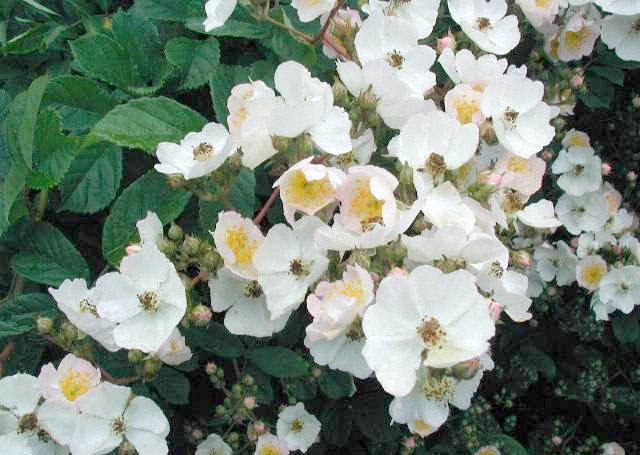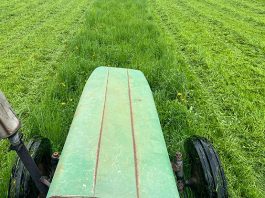 If you’re one of the folks who hate multiflora rose, you’re not alone. It’s been declared a noxious weed in almost all of the states where it’s found. Yet, it has many fine qualities. It makes a good rootstock for developing ornamental varieties of roses. That’s why it was originally imported from Japan. It’s also good at preventing erosion and acting as living fences, which is why the U.S. Soil Conservation Service promoted it in the 1930s. In the 1960s, the Virginia Highway Department planted it in medians to make drivers safer, reducing headlight glare and preventing cars from crossing into on coming traffic. Finally, birds and wildlife appreciate as habitat and a food source.
If you’re one of the folks who hate multiflora rose, you’re not alone. It’s been declared a noxious weed in almost all of the states where it’s found. Yet, it has many fine qualities. It makes a good rootstock for developing ornamental varieties of roses. That’s why it was originally imported from Japan. It’s also good at preventing erosion and acting as living fences, which is why the U.S. Soil Conservation Service promoted it in the 1930s. In the 1960s, the Virginia Highway Department planted it in medians to make drivers safer, reducing headlight glare and preventing cars from crossing into on coming traffic. Finally, birds and wildlife appreciate as habitat and a food source.
But there can be too much of a good thing. Since one multiflora rose can produce as many as 500,000 seeds per year, and seeds can remain viable in the soil for 10 to 20 years, it eventually became a problem for many farmers who would prefer more pasture than flowers. But here’s hope. Your livestock, no matter what you raise, can eat it, and control if for you.
 The beauty of multiflora rose as a forage is that its protein values run from 10 to 13 percent and it has no problematic toxins. That makes it a very palatable plant. I’ve seen goats, sheep and cows eat it without being harmed by the thorns. Grazing could also be a good way to control its spread. According to numerous fact sheets, frequent, repeated cutting or mowing at the rate of three to six times per growing season for two to four years, has been shown to be effective in achieving high mortality of multiflora rose. So, if eradication is you goal, put your four-legged mowers to work on your multi-flora rose at that rate. If that’s more fencing and labor than you care to invest, think of it as forage and let them graze it enough to manage the plant and prevent it from taking over your pastures.
The beauty of multiflora rose as a forage is that its protein values run from 10 to 13 percent and it has no problematic toxins. That makes it a very palatable plant. I’ve seen goats, sheep and cows eat it without being harmed by the thorns. Grazing could also be a good way to control its spread. According to numerous fact sheets, frequent, repeated cutting or mowing at the rate of three to six times per growing season for two to four years, has been shown to be effective in achieving high mortality of multiflora rose. So, if eradication is you goal, put your four-legged mowers to work on your multi-flora rose at that rate. If that’s more fencing and labor than you care to invest, think of it as forage and let them graze it enough to manage the plant and prevent it from taking over your pastures.
If your livestock aren’t already eating this beneficial forage, you’ll want to visit this page where I’ve collected all the resources and links to articles and videos you’ll need to get started.
Then to help you with multiflora rose in particular, here’s how it worked for Greg Angell, a farmer who came to a presentation I made in Hinton, West Virginia some years back, and then went home to teach his cows to eat multiflora rose. It took him about 10 days to have multiflora-rose-eating-cattle in his pasture.
Greg and I wrote back and forth as he went through the process so that I could answer questions that came up for him. Here are a few of Greg’s comments from our emails:
Day 5 – First feeding of multiflora rose:
” …the cows ate all of the multiflora rose that I put in the tubs with the exception of the little bit that fell out on the ground while they were eating. My Dad has been a little skeptical of the whole process, but he was surprised when we went back to the tubs and didn’t find any plant left in there.
“…I will let you know what happens after my evening feeding tomorrow (day 6). I told my Dad that we will have to buy some more cows once they start eating the multiflora rose. We have a lot of it in the edges of our pasture and the wooded areas we have fenced off.”

Day 8
“On day 5 when I introduced the multiflora rose with wheat bran, the cows (I was working with about 20 cows between the age of 1 ½ and 5) cleaned the tubs up. There was very little multiflora rose left in the tubs or on the ground. Day 6 produced the same results.
“Day 7 (yesterday) when I gave just the multiflora rose with no wheat bran, I only saw 3 cows (a 3 year old and two 1 ½ year old) eating multiflora rose from the tubs. The other animals all ran to the tubs and sniffed, but didn’t eat any. Should I have expected different results, or is this normal? Is there anything else I should do today on day 8?”
My answer to Greg’s question:
“If they’ve cleaned the tubs two days in a row, then they’ve gotten the good feedback from the plant and they know that is edible. So you’ve won that battle. If you have a few already eating the rose in pasture, I think you’ve won there too. Now what you want to do is encourage them to hang out near the multiflora rose patches. I wouldn’t bother feeding them anymore out of the tubs, but I would move the tubs over to the multiflora rose. You could throw bits of the rose in there, or maybe even leftovers from the training, but mostly the purpose of the tubs is to show them an area where they can eat. They’ll go check the tubs, hang out there a bit, and check out the plant. It sounds like you have multiflora rose eating cows now. They just need some time to practice and get going. Don’t worry. They will start out slowly and get better and better at it.”
Day 9
Greg: “As I was harvesting multiflora rose yesterday, Dad asked me if I had been harvesting in an area where he was. I told him, “no”. After telling him that, he seemed to think the cows had been there eating on them. Also after the day 6 feeding, I watched the animals and a couple of the smaller ones (hopefully two of the cows I witnessed eating from the tubs on day 7) headed to the woods and started picking from the multiflora rose.”
Day 10 or 12?
Greg: Well, we had been watching the cows but hadn’t seen much out of the ordinary on Thursday. However, on Friday, I was on my way home from work and my Dad called me. He had went to the tubs to move them around and all of the multiflora rose that we had put in them on Wednesday were gone! We were both pretty excited. We then went down in the woods where the cows had been and found several of them eating multiflora rose. Dad was really relieved, because he knew they would eat them after finding the tubs empty, he just didn’t want to have to cut them and put them in the tubs to get them to eat…:-). Thanks for all of your help and advice! I’ll keep you posted as things progress.
I hope this helps you turn a problem into forage!





Multiflora rose is abundant in my pastures and does not seem to be going away even after a few years of mowing and grazing. My sheep do eat it, neatly plucking the leaves from the thorny stems.
Do you have more information on the nutritive value of multiflora rose in addition to its protein content? And more generally, any advice on estimating available dry matter, crude protein and TDN in wild pastures containing a large variety of weeds of different heights and growing habits, which may or may not be palatable to sheep? I want to use grazing to manage the weeds but I want to be sure the sheep have enough of the right kind of food too.
Comments are closed.